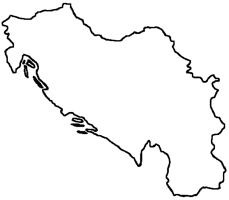
|
The Society of Folk Dance Historians (SFDH)
The Inner Joy of Yugoslav Dancing
[
Home |
About |
Encyclopedia | CLICK AN IMAGE TO ENLARGE |

|
 Yugoslavia, one of the five Balkan countries, is physiographically and ethnically a most complex country. A rough terrain isolating segments of the population and years of conquest and occupation by many nations have interwoven scattered remnants of culture into the underlying native folkways. These factors are reflected in the diversity and complexity of its folk dances.
Yugoslavia, one of the five Balkan countries, is physiographically and ethnically a most complex country. A rough terrain isolating segments of the population and years of conquest and occupation by many nations have interwoven scattered remnants of culture into the underlying native folkways. These factors are reflected in the diversity and complexity of its folk dances.
Seen from a passing satellite, Yugoslavia would appear to be a tangled network of densely wooded, inhospitable mountains pocked with boulder-strewn valleys. Its mountains, which are bordered by other Balkan countries, fall away to a broken coastline washed by the Adriatic Sea.
Five South Slav peoples make up the Yugoslav population: Serbians, Croatians, Slovenians, Macedonians, and Montenegrins. "Yug" is the Slav word for "south," so the literal meaning of Yugoslavia is "land of the South Slavs." Linguistically, the national groups are closely related through four main languages, but historical and cultural differences have been the cause of tensions and rivalries. Diversity within a fundamental unity is a major theme of Yugoslav history.
The principal centers of population are in the fertile lowlands and along the maritime frontage of the Adriatic Sea. On the Croatian coastal regions and in Dalmatia, next to the dazzling blue of the Adriatic Sea where tourists swarm today, life a mere decade ago was a nightmare due to chronic afflictions visited on Yugoslavia as well as other Balkan lands by invaders. There are now great universities in the large cities, whereas once the Yugoslavs were deprived by conquerors of the right to an education.
In the period of decline of the Roman Empire, great migrations took place, resulting in ethnic mixtures. Then darkness fell over a large part of the South Slav land when the Turks began a five-hundred-year siege by defeating its strongest state, Serbia, in 1389. Despite the fact that one of the first printing presses in the world was established there in 1494, the Turkish invasion brought to a halt the rapid development of the South Slav civilization, which at that time had developed an advanced literature. The people were subjugated and were prevented from publicly using their language and literature and developing their culture. Though the fierce resistance of the Yugoslavs continued throughout those many years of Turkish domination, the long rule of the Ottoman Empire is evidenced by the mosques and palaces that may still be seen in certain areas of the country.
Others besides the Turks coveted the rich lands of the South Slavs, however, and for centuries the Republic of Venice (later Italy) sought a foothold on the Dalmatian coast. The Austrians and Hungarians came to take what they felt was their share of the spoils. The struggle for independence reached its climax during the last 150 years, which saw 28 separate rebellions. Intellectual ferment, political struggle, and internal strife plagued the country between World War I and II. Hard-fought battles against invading Nazi forces during World War II ended in 1945 with the establishment of the Federal People's Republic of Yugoslavia, composed of six republics: Slovenia, Croatia, Bosnia-Herzegovina, Montenegro, Serbia, and Macedonia.
Yugoslav folk art is rooted in rich cultures dating from the time fo the fall of the Byzantine Empire and the onslaught of the destructive Ottoman Empire of the Middle Ages. Solely permitted to express their feelings orally, Yugoslavs recited or sang them to the accompaniment of local instruments. Folk stories were transmitted from father to son and were given expression in ballads and music, elaborate embroidery, intricate wood carving, and a rich dance tradition. These highly developed folk arts, which are of more than mere ethnographic interest, have been preserved in the recent past. Of these folk art forms, none is livelier than the enormously variegated Yugoslav dances. These include not only the Kolos (circle dances) but also a number of other dances, such as heroic dances, children's dances, and community dances.
The Kolos can be divided into two groups: ritual dances, which have all but disappeared, and a secular group of dances. In the latter group, happy, lively dances predominate, a fact that is in keeping with the spirit of the Yugoslav peoples. These dances often stress bravery and endurance. Apart from these, there are humorous, mimicking dances in which animals are imitated; sentimental dances; dances that mark the beginning or end of a social gathering; and erotic dances. The humorous dances, besides being happy, may also strike out at such undesirable traits as laxness and dishonesty. In some dances the elements of mimicry assume the character of a small play in which the words of the accompanying songs describe the action performed in the dances.
In addition to countless dances expressing joyous feelings, there are also sentimental and romantic ones. Among the latter, those from Macedonia are especially lovely. The emotional musical accompaniment may signify longing for the homeland, while the drooping heads of the dancers may express a staggering under the burden of a yoke. In some parts of the country it is the custom for women to mourn their dead in Kolos. Erotic feelings are implied in the majority of couple dances, but they allude to love and longing in a discreet way.
Yugoslav dance rhythms are nearly as varied as the dances themselves. The standard Western 2-beat rhythm is found in such dances as U Šest Koraka from Serbia, Slavonsko Kolo from Croatia, and Belasičko Oro from Macedonia, while Biserka from Serbia reflects the 3-beat rhythm popular at elegant balls at the turn of the century. Other rhythms are also possible, combining "quick" beats of two counts each and "slow" beats of three counts each. For example, Tino Mori utilizes a 7-count slow-quick-quick (3-2-2 = 7) rhythm while Čamče has a 7-count quick-quick-slow (2-2-3 = 7) rhythm. More complicated rhythms are evident in Četiri U Krst (3-2-3 = 8), Čučuk (2-2-2-3 = 9), Fatiše Kolo (2-3-2-2 = 9), Ovčepolsko Oro (2-2-3-2-2 = 11), and Postupano (2-2-2-3-2-2 = 13). There are even examples of combined or alternating rhythms in such dances as Ergensko Oro (2-3-2-2 = 9 + 2-3-2-2-2-2 = 13) and Pop Marinko (2-2-2-3 = 9 + 3-3-2-3 = 11).
It is often awkward to give English equivalents to the many different Kolo steps, but because some steps occur frequently, especially in dances of the same area, we can recognize a few of the more common denominators that are significant in the repertoire of the Kolo dancer. In addition to steps – which often have a quick bend of the knee between them in series – and hops – which are more like simple lifts of the heel, with the free foot staying very near to or on the floor – some basic combinations fo these with which the Kolo dancer rapidly becomes familiar include step-hop and hop-step-step. There are also running threes (a series of three running steps), unsyncopated threes (steps danced on three even counts), and syncopated threes (three steps in which the first or last is held longer than the other two). This last step may be done very fast with a shaking of the body, as in the Croatian Drmeš. A grapevine step, consisting of crossing in front and in back (or vice versa), is popular in Serbian dancing. One particular step combination, commonly called the basic Kolo step, probably evolved from a simple sideward step-close-step pattern. It combines a sideward hop-step-step and a step-hop in a two-measure phrase. It is easy to predict on these component steps that new material will be researched and presented for years to come.
Of the regional styling of Yugoslav dance it can be generally said that the body is held proudly erect, the knees are slightly flexed, and the footwork is usually small and kept close to the floor. While the men's steps are often flashy and vigorous, the women's steps are usually more restrained. A man usually leads the Kolo in Yugoslavia and may start a dance with only one or two more dancers, who may later be joined by others.
The handholds used in Yugoslav< dancing are many. Besides the couple dance positions, which include the varsouvienne, shoulder-waist, and closed ballroom, the greatest variety occurs in the Kolos. Basket holds, both front and back, are prominent in the north; low or "V" handholds are widespread in central Yugoslavia; and belt holds, shoulder holds, and joined hands held at shoulder level in "W" handholds may be found in the south. These handholds are not, of course, limited to just the areas mentioned. In addition, little finger holds, middle finger holds, and escort hold are known.
In the last twenty-five years, Kolos have become more and more popular with folk dancers all over the United States and Canada. Not only have folk dancers in general accepted them as belonging on the list of dances to be learned and danced often, second-generation Yugoslavs have also taken a much greater interest in Kolo dancing. Both groups enjoy these dances at their parties and celebrations and both try to learn them correctly. Whether at ethnic gatherings, folk dance festivals, or civic celebrations, these dances usually headline a program of exhibition dances.
In order to feed this growing interest and introduce dancers to the joie de vivre of the Yugoslav people, many teachers of Yugoslav dances have appeared on the American and Canadian folk dance scene. Notable among these in the formative years of United States Kolo dancing were Vyts Beliajus, Michel Cartier, Dick Crum, John Filcich, Michael and Mary Ann Herman, and Anatol Joukowsky. A significant impact in the field of folk dancing was later made by Dennis Boxell, Marty Koenig, Atanas Kolarovaski, and George Tomov. More recently, Bora Gajicki, Elsie Dunin, Anthony Shay, Bob Leibman, Ron Wixman and others have contributed to bring Yugoslav dancing to the folk dance public. While this list is by no means complete, it illustrates that interest inYugoslav dance in the United States has been steadily on the upswing – for without that interest there would not have been such a demand for so many specialty teachers.
And what of the future of Yugoslav dancing in the United States? The hope is that the "Kolo Maniac" and "Balkan Freak" labels will become things of the past as the "hotshots" place less importance on collecting yet more dances and begin to experience the inner joy of Yugoslav dancing.
Ten years after this article was written, Yugoslavia was thrust into a civil war that resulted in the secessions of Bosnia-Herzegovina, Croatia, and Slovenia (1992), with Macedonia peacefully separating a short time later (1993). Montenegro later declared independence (2008). Serbia (along with Kosovo), the only remaining state within Yugoslavia, adopted a new constitution and proclaimed itself to be the "Federal Republic of Yugoslavia (2008). Then Kosovo declared its independence from Serbia (2008).
DOCUMENTS
- Dick Oakes, an article.
- Yugoslavia, a former country.
From Betty Casey's book, International Folk Dancing U.S.A.,
Doubleday & Company, Inc., Garden City, New York, 1981.
Used with permission of the author.
This page © 2018 by Ron Houston.
Please do not copy any part of this page without including this copyright notice.
Please do not copy small portions out of context.
Please do not copy large portions without permission from Ron Houston.